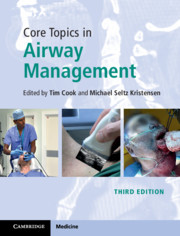Book contents
- Core Topics in Airway Management
- Core Topics in Airway Management
- Copyright page
- Contents
- Contributors
- Foreword
- Preface to the Third Edition
- Section 1 Airway Management: Background and Techniques
- Section 2 Airway Management: Clinical Settings and Subspecialties
- Chapter 22 The Airway in Obstetrics
- Chapter 23 The Paediatric Airway
- Chapter 24 Airway Management in Obesity
- Chapter 25 Maxillofacial and Dental Surgery
- Chapter 26 Ear, Nose and Throat Surgery: Airway Management
- Chapter 27 Lung Separation
- Chapter 28 Airway Management in the Critically Ill
- Chapter 29 The Patient with a Tracheostomy
- Chapter 30 Pre-hospital and Trauma Airway Management
- Chapter 31 Airway Management during CPR
- Chapter 32 The Bloody and Bleeding Airway
- Chapter 33 The Airway in Anaesthesia for Transoral Robotic Surgery
- Section 3 Airway Management: Organisation
- Index
- References
Chapter 27 - Lung Separation
from Section 2 - Airway Management: Clinical Settings and Subspecialties
Published online by Cambridge University Press: 03 October 2020
- Core Topics in Airway Management
- Core Topics in Airway Management
- Copyright page
- Contents
- Contributors
- Foreword
- Preface to the Third Edition
- Section 1 Airway Management: Background and Techniques
- Section 2 Airway Management: Clinical Settings and Subspecialties
- Chapter 22 The Airway in Obstetrics
- Chapter 23 The Paediatric Airway
- Chapter 24 Airway Management in Obesity
- Chapter 25 Maxillofacial and Dental Surgery
- Chapter 26 Ear, Nose and Throat Surgery: Airway Management
- Chapter 27 Lung Separation
- Chapter 28 Airway Management in the Critically Ill
- Chapter 29 The Patient with a Tracheostomy
- Chapter 30 Pre-hospital and Trauma Airway Management
- Chapter 31 Airway Management during CPR
- Chapter 32 The Bloody and Bleeding Airway
- Chapter 33 The Airway in Anaesthesia for Transoral Robotic Surgery
- Section 3 Airway Management: Organisation
- Index
- References
Summary
For many thoracic operations lung separation to enable collapse of the operated lung is either necessary or useful for successful surgery. Lung separation may also be required in other settings for management of pulmonary bleeding, infection or complicated lung ventilation. Lung separation requires knowledge, skill and attention to detail. New technology including videolaryngoscopy, tracheal tubes incorporating distal cameras and improvements in bronchial blocker technology have added to the anaesthetist’s armamentarium. This chapter describes the indications, techniques and complications of lung separation of relevance to generalist and specialist anaesthestists.
- Type
- Chapter
- Information
- Core Topics in Airway Management , pp. 243 - 249Publisher: Cambridge University PressPrint publication year: 2020

